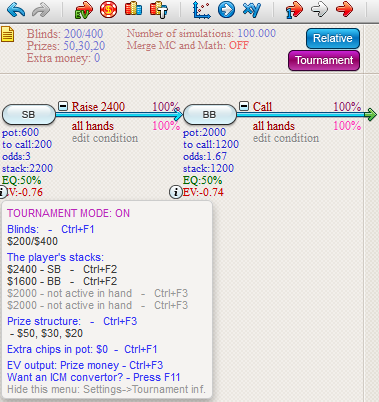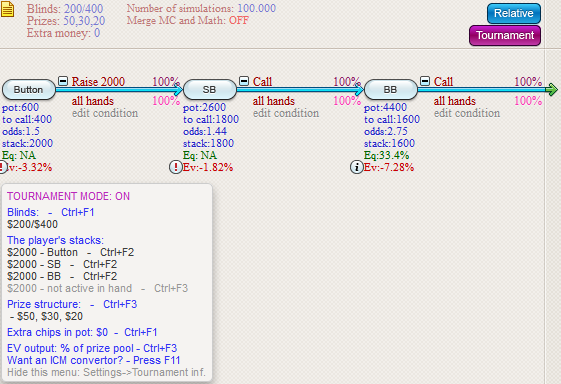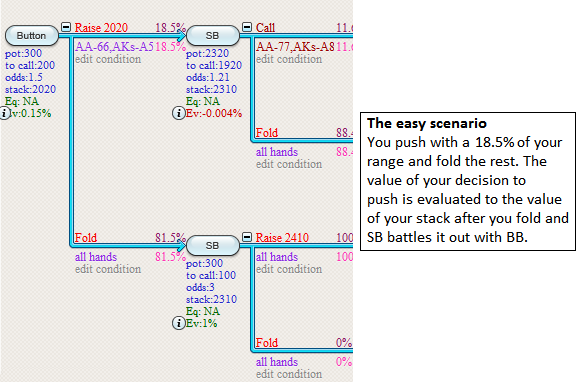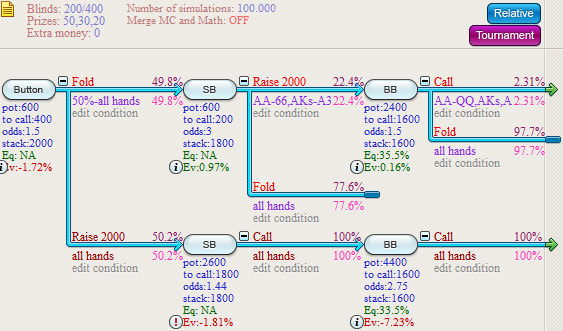Multiway hands in tournaments
Evaluating the EV of decisions in multiway hands
The EV of a decision is always calculated in comparison to what happens if we would have folded.
In cash games this is trivial.
However, in tournaments, there may still be players left to act after you fold.
In that case it becomes mathematically impossible to determine what outcome our decision needs to be compared to.
Of course, the program could make some assumptions and make an educated guess, but no matter how this would be simulated,
the user would have no way of knowing what scenario is used as the origin.
For that reason the software offers you the option of defining for yourself what happens after folding.
Let's look at four different situations.
In the last it's impossible to give a mathematically factual outcome.
The user can therefore define his own desired outcome there.
Situation 1: Cash games (trivial)
In cash games, the EV of a decision is always considered in comparison to folding.
For example, if you have a stack of $100 and a certain decision will on average mean that you'll end up with a stack of $102,
then the EV of the decision is considered $102-$100=$2.
Situation 2: Tournaments, two active players (trivial)
Similarly, if there's only two active players left in a tournament hand, then again we can easily compare the EV of a decision to folding.
After all, we know that after one player folds, the other player wins the pot, meaning that we know the stack distribution after folding.

Example:
In the pic above we have a tournament with 4 players.
The first two players have a stack of 2000, SB has a stack of 2400 and BB has a stack of 1600 (this is easiest to see in the tournament info window in the lower left).
In the tree above, the first 2 players fold and SB now shoves.
BB calls with "all hands".
When calculating the EV for BB's spot, the outcome after this all-in will be need to be compared to the stack distribution that would have occurred if BB would have folded.
Given that the blinds are 200/400 (see upper left of screenshot) this stack distribution after folding would be 2800/1200/2000/2000.
To see an elaborate example calculation of how to calculate BB's EV in this spot, please go here.
In order to inform you that the software was successful in determining the outcome after folding, a  icon is drawn to the lower left of BB's decision. For
more on these icons, go here.
icon is drawn to the lower left of BB's decision. For
more on these icons, go here.
Situation 3: Tournaments, all other active players are all-in (trivial)
For example, see the spot below. Button pushes, SB calls and BB calls.
In evaluating the EV for BB's decision the software is again capable of determining what would have happened if BB had folded.
After all, both Button and SB are all-in, so if BB would fold, they would go to showdown.
Again, in order to indicate that the software has succesfully found an outcome for if BB would have folded, a  icon is drawn to the lower left of his decision.
icon is drawn to the lower left of his decision.

On the other hand, a player like SB has a  to the lower left of hís decision.
This is because it's NOT known what BB will do if SB folds.
So there's no way of setting an origin with which SB's call action should be compared.
For more on thése types of spots, please see situation 4 below.
And again, for more on the icons
to the lower left of hís decision.
This is because it's NOT known what BB will do if SB folds.
So there's no way of setting an origin with which SB's call action should be compared.
For more on thése types of spots, please see situation 4 below.
And again, for more on the icons  and
and  , go here.
, go here.
Situation 4: At least one active player still has to make a decision after we fold (problem)
Now thís situation is one where we can't say for certain what will happen after we fold.
It would of course be possible to make the program come up with a possible scenario, however, the user would be left in the dark as to what is assumed to happen after a fold.
Since this is a calculator, and unknown factors are not desirable, the software offers you the option of defining what happens after folding yoursélf.
In order to do this all you'll need to do is add a fold to the decision and make sure at least 10% of all the simulation runs go through this fold action.
A "Fold" action is already present
Possibly you've already added such a fold because you're calling/betting/raising some of your range and folding the rest.
In this case all your decisions are evaluated in comparison to what happens after that fold. And again, in this case, a  icon is drawn to the lower left of the player's decision
in order to indicate that the software has succeeded in finding an origin.
Like in the screenshot below where there's a "Fold" action present in Button's decision.
The EVs in his raise action will be evaluated in comparison with the value of this "Fold" action.
icon is drawn to the lower left of the player's decision
in order to indicate that the software has succeeded in finding an origin.
Like in the screenshot below where there's a "Fold" action present in Button's decision.
The EVs in his raise action will be evaluated in comparison with the value of this "Fold" action.

Adding an artificial fold if no "Fold" action is present
However, sometimes a situation will occur where you wish to, for example, push "all hands".
In this case you'll have to work out how to artificially add a fold to the decision so that you have a reference point.
In order to do that, just add a "Fold all hands" action on top of the decision and define what happens after the fold.
Now, give the fold a weight of, for example 50%, so that a decent portion of the simulations pass through it.
And now, the decision to push will be compared to that of the artificially added "fold" action.
For example, in the pic below, Button's "Raise 2000" action is now compared to the artificially added "Fold" action on top.

Now, please observe that by adding the Fold action the EV of the decision as a whole has been compromised.
It's now a mixture of the Raise and the Fold action.
To get the data of the "Raise" action itself, move your mouse pointer over it, to get its popup.
Also, please note that there's still a  icon displayed to the lower left of SB's "Call" decision.
This is because for thát decision it's still not known what would happen if SB folded instead, since BB is still left to act.
There's no need to do anything here though, unless you are specifically interested in that decision. Otherwise you can simply ignore it.
The EV data at one decision does not affect the EV of other decisions.
icon displayed to the lower left of SB's "Call" decision.
This is because for thát decision it's still not known what would happen if SB folded instead, since BB is still left to act.
There's no need to do anything here though, unless you are specifically interested in that decision. Otherwise you can simply ignore it.
The EV data at one decision does not affect the EV of other decisions.
| << Previous | Contents | Next >> |
